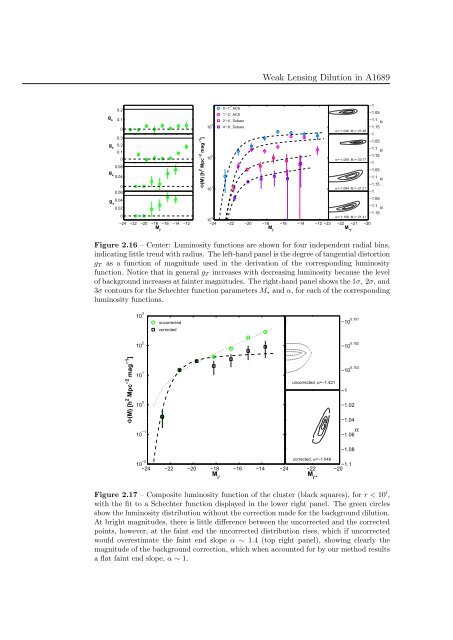Mass and Light distributions in Clusters of Galaxies - Henry A ...
Mass and Light distributions in Clusters of Galaxies - Henry A ...
Mass and Light distributions in Clusters of Galaxies - Henry A ...
Create successful ePaper yourself
Turn your PDF publications into a flip-book with our unique Google optimized e-Paper software.
Weak Lens<strong>in</strong>g Dilution <strong>in</strong> A1689<br />
g +<br />
−1<br />
0’−1’, ACS<br />
0.2<br />
−1.05<br />
1’−2’, ACS<br />
0.1<br />
2’−4’, Subaru<br />
−1.1 α<br />
0<br />
10 3 4’−8’, Subaru −1.15<br />
α=−1.046 M *<br />
=−21.46<br />
−1<br />
0.3<br />
−1.05<br />
g +<br />
0.2<br />
0.1<br />
−1.1 α<br />
0<br />
10 2<br />
−1.15<br />
α=−1.059 M *<br />
=−20.77<br />
−1<br />
0.08<br />
g + 0.04<br />
−1.05<br />
−1.1 α<br />
−1.15<br />
0<br />
10 1<br />
α=−1.094 M *<br />
=−21.21<br />
0.06<br />
−1<br />
0.04<br />
−1.05<br />
g +<br />
−1.1<br />
0.02<br />
α<br />
−1.15<br />
0<br />
10 0<br />
α=−1.108 M *<br />
=−21.41<br />
−24 −22 −20 −18 −16 −14 −12 −24 −22 −20 −18 −16 −14 −12 −23 −22 −21 −20<br />
M i’<br />
M i’<br />
M *i’<br />
Φ(M) [h 2 Mpc −2 mag −1 ]<br />
Figure 2.16 – Center: Lum<strong>in</strong>osity functions are shown for four <strong>in</strong>dependent radial b<strong>in</strong>s,<br />
<strong>in</strong>dicat<strong>in</strong>g little trend with radius. The left-h<strong>and</strong> panel is the degree <strong>of</strong> tangential distortion<br />
g T as a function <strong>of</strong> magnitude used <strong>in</strong> the derivation <strong>of</strong> the correspond<strong>in</strong>g lum<strong>in</strong>osity<br />
function. Notice that <strong>in</strong> general g T <strong>in</strong>creases with decreas<strong>in</strong>g lum<strong>in</strong>osity because the level<br />
<strong>of</strong> background <strong>in</strong>creases at fa<strong>in</strong>ter magnitudes. The right-h<strong>and</strong> panel shows the 1σ, 2σ, <strong>and</strong><br />
3σ contours for the Schechter function parameters M ∗ <strong>and</strong> α, for each <strong>of</strong> the correspond<strong>in</strong>g<br />
lum<strong>in</strong>osity functions.<br />
10 3 uncorrected<br />
corrected<br />
−10 0.151<br />
10 2<br />
−10 0.152<br />
Φ(M) [h 2 Mpc −2 mag −1 ]<br />
10 1<br />
10 0<br />
10 −1<br />
uncorrected, α=−1.421<br />
M i’<br />
−10 0.153<br />
−1<br />
−1.02<br />
−1.04<br />
α<br />
−1.06<br />
−1.08<br />
10 −2<br />
−24 −22 −20 −18 −16 −14<br />
M i’<br />
corrected, α=−1.048<br />
−24 −22<br />
M i’*<br />
−20 −1.1<br />
Figure 2.17 – Composite lum<strong>in</strong>osity function <strong>of</strong> the cluster (black squares), for r < 10 ′ ,<br />
with the fit to a Schechter function displayed <strong>in</strong> the lower right panel. The green circles<br />
show the lum<strong>in</strong>osity distribution without the correction made for the background dilution.<br />
At bright magnitudes, there is little difference between the uncorrected <strong>and</strong> the corrected<br />
po<strong>in</strong>ts, however, at the fa<strong>in</strong>t end the uncorrected distribution rises, which if uncorrected<br />
would overestimate the fa<strong>in</strong>t end slope α ∼ 1.4 (top right panel), show<strong>in</strong>g clearly the<br />
magnitude <strong>of</strong> the background correction, which when accounted for by our method results<br />
a flat fa<strong>in</strong>t end slope, α ∼ 1.
















